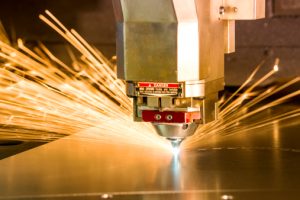Fives Landis has been a leader in specialist grinding technology for decades, especially for automotive crankshafts. But with the shift to electric vehicles reducing demand in that market, the team saw a lucrative new opportunity: the bearings market, particularly high-value, low-volume bearings for aerospace, energy and precision machinery.
Through conversations with leading bearings manufacturers, it became clear that these parts were often painfully slow to make. Complex inner and outer features had to be ground on multiple machines, at multiple sites, over many weeks. Landis had an idea: take the innovative Twin Turret Grinder (TTG) they’d developed for optics and re-engineer it into a bearing grinder that could do everything in a single run, with world-leading precision.
The only problem was finding the time, people, and budget to make it happen.
Fives Landis secured grant funding, through the Advanced Machinery and Productivity Institute (AMPI), to support the machine design phase. This gave them the resources to dedicate an internal team with deep knowledge of the TTG platform, rather than trying to squeeze it in piecemeal between other projects.
AMPI also connected them with the University of Huddersfield, whose expertise in geometric error analysis helped perfect the machine’s design and real-time correction software. Two top-tier software engineers were brought in to enhance the digital twin, so customers can program parts and simulate cycles offline with near-perfect accuracy.
“We’ve always recognised the potential value of university partnerships but it’s always been surprisingly hard to make work. Through AMPI we found the right people without even trying, and AMPI made setting up terms of work easy”.
Derry Faulkner, Engineering Consultant, Fives Landis
The resulting TTG 3000 retains the twin-turret concept – one turret holds the grinding wheel, the other the workpiece – mounted on perfectly symmetrical castings. This is a key feature in ensuring precision – when the machine warms up, both turrets expand evenly apart rather than bending, which can be easily corrected for by the control software. That thermal stability means tolerances stay within a couple of microns.
Its long “virtual axis” and supporting control software – also adapted from the original machine – allows the grinding wheel to reach both the front and back faces of large bearings in one setup.
The first TTG 3000, which shipped mid 2025, cut a process – that previously involved nine machines, two sites, and 16 hours of grinding spread over months – down to a single 30-minute run, with the customer confident they can get it to ten minutes. Across hundreds of parts, they’ve never seen thickness variation beyond a micron.
“This is the first high-end bearing grinding machine fully designed and built by a UK company, and nothing else like it exists in the world. Despite being new to this market, we are already winning new business. The combination of robust design and our own precision control tools is a game-changer for bearing manufacturers. What’s more, this is a 100% Fives Landis machine fully designed, built, and owned by Landis. It would probably not have happened, and certainly not this quickly, without the AMPI funding and the Huddersfield partnership.”
Mark Stocker, CTO, Fives Landis.

Innovation for Machinery (I4M) is a funding scheme that provides SME businesses in Greater Manchester and West Yorkshire with access to advanced machinery expertise to accelerate the development of the next generation of machinery and create new jobs and growth in this sector.rnrnWe’ve recently launched our I4M Industry Training route which offers up to £5,000 per person (up to two awards per company) for training that develops the diverse expertise needed to design, build, install, and maintain advanced machinery.
Explore our new funding route